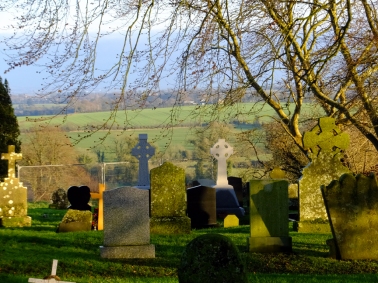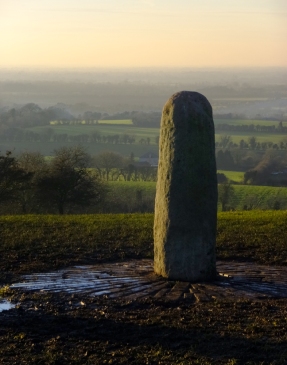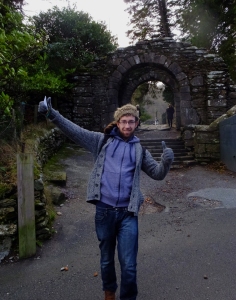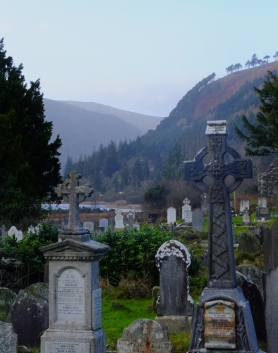Tags
Daniel O'Connell, fairy trees, Glendalough, Hill of Tara, Ireland, Lia Fáil, Mound of the Hostages, Neolithic, Newgrange, Reefert Church, St. Kevin, St. Kevin's Cell, Stone of Destiny, Valley of two lakes, Wicklow Mountains
FailteIreland.ie, the web site of Ireland’s official tourism development bureau, now promotes “Ireland’s Ancient East” as a tourist destination. They hope to duplicate the success they had in the west with the “Wild Atlantic Way” concept. It is likely that they will succeed, since Ireland’s Ancient East has amazing sites to visit and wonderful stories to tell. In this post we’ll visit three of them: The massive Neolithic monument of Newgrange, the historic and legendary Hill of Tara, and the magical valley of Glendalough.
Click on a photo to see it larger. It will open in a new window.
Newgrange
With good planning and an early start, a visitor could combine Newgrange with Tara into one day trip. A couple hours at each are enough for the casual visitor to take them in.

From the Newgrange visitors center, visitors are assigned to tour groups and are taken by bus to the site itself. This photo was taken from the bus as we approached. Newgrange appears first as a massive mound in the distance, behind fields of grazing sheep.

Our tour guide filled us in on what is known and what is speculated about how and why this Neolithic structure was constructed about 5,000 years ago.

It is thought to have had a religious significance, but that story is lost to time. This elaborate, complex monument predates England’s Stonehenge and Egypt’s pyramids.

The guide handed out flashlights and took us through this entrance behind huge, spiral-etched stones. We followed a long, dark, narrow, irregular passage. Every year, at sunrise on the winter solstice, and only on that day, a beam of light passes through the rectangular opening over the entrance, and illuminates the altar in the chamber at the center of the mound.

I emerged with a sense of awe and wonder, privileged to have visited the chamber. As you might imagine, to be inside on the morning of the winter solstice would be the ultimate privilege. Only a handful of people get to witness that moment, and they are chosen by lottery.

After the tour, visitors are given time to wander the grounds, touch the ancient standing stones, and soak it all in.

To visit Newgrance is to gain a much deeper appreciation of the depth and breadth of Irish contributions to civilization. Here, Sarah communes with the stones.
The Hill of Tara
While some structures on the Hill of Tara date from the time of Newgrange, its continuing use through the intervening centuries has caused its history to be better documented than that of Newgrange, so more is known about it.

St. Patrick’s early 19th century church and graveyard are the first things visitors encounter when entering the hill complex.

At first, it appears that there is not much at all on the hill, but a map of the site reveals that these rolling hills are the remains of ring forts and ceremonial enclosures of various kinds.

In the middle of one ring is this standing stone, believed to be the Lia Fáil (Stone of Destiny) at which the High Kings of Ireland were crowned. According to legend, the stone would scream if a series of challenges were met by the would-be king. At his touch the stone would let out a screech that the legend says could be heard all over Ireland.

The small passage tomb built into a hill known as “The Mound of the Hostages” has been dated at 3,000-2,500 BC. Like Newgrange, but much smaller, the entrance is aligned to mark astronomical events.

Whatever contents were once inside have long since decayed or have been removed. The remains of more than 40 individuals have been recovered from inside the mound and the tomb.

These children almost appear to be dancing to an ancient Celtic tune atop the Mound of the Hostages.

In 1843, Ireland’s Great Emancipator, Daniel O’Connell, hosted a peaceful political demonstration on the Hill of Tara to protest Britain’s repressive Act of Union. The rally drew over 750,000 people to this spot.

Families now use the Hill of Tara as a place to enjoy the outdoors, frolicking among the ancient stones.

Old, twisted trees stand on the Hill of Tara. Legend has it that these are among Ireland’s magical “fairy trees.”

Some visitors tie little colorful ribbons to the branches of the fairy trees, in the hope that a wish will be granted.
Glendalough
Glendalough (Gleann Dá Loch in Irish) means “Valley of two lakes.” It is a glacial valley in County Wicklow. In this beautiful setting, St. Kevin founded an Early Medieval monastic settlement in the sixth century.

Despite the altitude, and even in January, with leaves gone for the winter, much of the valley was covered in lush growth.

A well-preserved round tower stands in the graveyard. These towers were used as a last defensive resort. The only entrance was high in the tower, and the ladder could be pulled up inside.

Sarah made the long climb to St. Kevin’s Cell while I followed a stream in the valley, taking pictures there.
In late January, 2015, we returned to the USA after six months in Europe. It is only now, months later, that we are finally finishing the story of the adventure. Thank you to all who accompanied us on the journey via this blog!
Charlie Sawyer & Sarah Robinson
Apalachicola, Florida, USA

Note: The photo above this one was taken by this guy. Thank you to all the fellow travelers who took pictures of Sarah and I together on this adventure!























Sarah and Charlie – what a wonderful job of sharing your trip. I am sorry it has ended. Thank you so much.
LikeLike
Great blog, looks like wonderful trip. Glad you had fun and made it home safely.
LikeLike
Thank you, Charlie and Sarah, for letting us travel with you and enjoy vicariously your 6 months in Europe.
LikeLike
Wow Wow Wow and somemore Wowwing……Mahalo Charlie. Here is a toast to your taking pictures here!
LikeLike
Thanks Your Blueness! I’d love to take pictures on your beautiful islands!
LikeLike